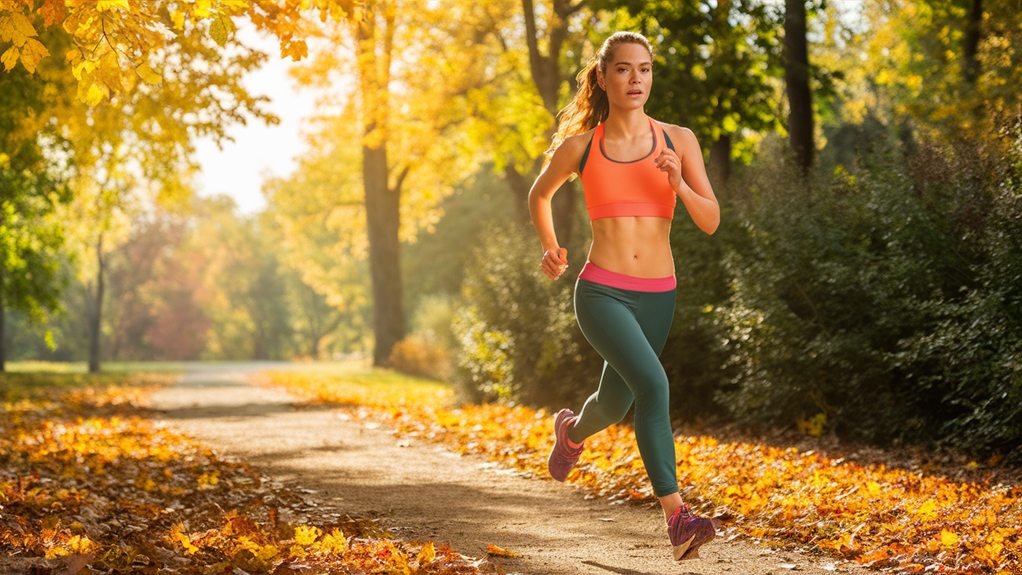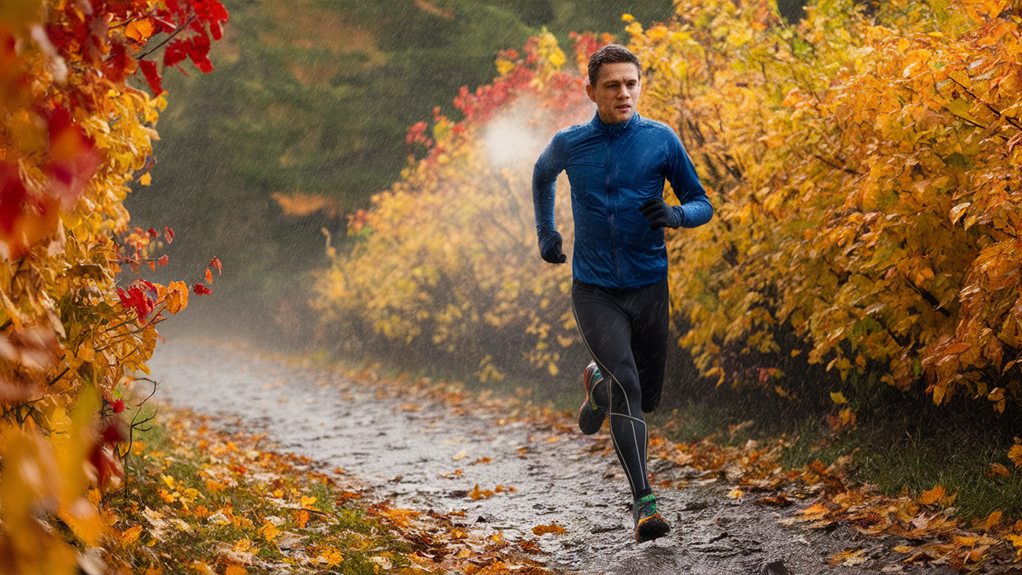Outdoor cardio activities offer an invigorating way to boost your fitness while enjoying nature's benefits. You'll find plenty of options to choose from, including running, power walking, hiking, cycling, and team sports like basketball or soccer. Working out in nature not only burns more calories than indoor exercise but also improves your mental well-being through exposure to fresh air and sunlight. To get started, you'll need proper gear like moisture-wicking clothes, supportive shoes, and weather protection. Remember to stay hydrated, warm up properly, and check weather conditions before heading out. There's much more to discover about maximizing your outdoor fitness journey.
Why Take Your Workouts Outside

Freedom awaits when you step outside for your cardio workout. Leaving the confines of a stuffy gym opens up endless possibilities for the best outdoor cardio workouts, allowing you to breathe fresh air while burning calories.
When you're surrounded by nature's beauty, you'll find that time passes more quickly, and your motivation soars to new heights. For those with joint issues or beginners, engaging in gentle cardio options like walking or swimming can be particularly beneficial, making outdoor activities even more accessible and enjoyable gentle cardio options.
Looking for outdoor cardio for weight loss? You'll discover that exercising in varying terrain and weather conditions can boost your calorie burn by up to 20% compared to indoor workouts. Your body works harder to adapt to uneven surfaces, wind resistance, and temperature changes, making each session more effective.
There are countless fun outdoor cardio activities to choose from, each offering unique benefits for your mind and body.
Whether you're jogging through a park, cycling along scenic trails, or doing bodyweight exercises in your backyard, you'll experience reduced stress levels and increased vitamin D production. The natural environment also provides constant visual stimulation, which helps maintain focus and reduces the monotony that's often associated with indoor exercise routines.
Popular Outdoor Cardio Options
Enthusiasts and beginners alike can choose from a wide range of effective outdoor cardio activities. Whether you're looking for low-impact options or intense workouts, there's something for everyone who wants to make outdoor cardio fun and engaging.
Exploring diverse cardio workouts can help you find the right fit for your fitness level and goals. Running and jogging remain popular choices, letting you set your own pace while exploring neighborhood streets or local trails.
If you prefer variety, try power walking with intervals of speed bursts, or incorporate hiking on challenging terrain to work different muscle groups. Cycling offers another excellent option, allowing you to cover more distance while enjoying scenic routes and invigorating air.
For those seeking social interaction, team sports like basketball, soccer, or ultimate frisbee combine cardio benefits with friendly competition.
You'll also find that jumping rope, which you can do almost anywhere outdoors, provides an incredibly effective workout that improves coordination and stamina.
During warmer months, swimming in outdoor pools or natural bodies of water offers revitalizing, full-body cardio that's gentle on your joints.
For a unique twist, try combining activities, such as alternating between running and bodyweight exercises at local parks.
Health Benefits Beyond Exercise

The great outdoors offers more than just a place to exercise – it's a natural boost for your overall well-being. When you're moving your body outside, you'll breathe in fresh air that helps clear your lungs and strengthen your immune system. Engaging in cardiovascular exercise outdoors can enhance your heart health and improve endurance, further contributing to your fitness goals.
The natural sunlight you'll soak up helps your body produce vitamin D, which strengthens your bones and improves your mood.
You'll notice that outdoor cardio activities can greatly reduce your stress levels, as the combination of nature's sights, sounds, and smells creates a calming effect on your brain. The varied terrain and changing environments you'll encounter help improve your balance, coordination, and spatial awareness.
When you're exercising outdoors, you'll also experience better mental clarity and creativity, as nature has a way of clearing mental fog and boosting cognitive function.
Your sleep patterns will likely improve too, as outdoor exercise helps regulate your body's natural circadian rhythm. Plus, you'll develop a stronger connection to your environment, which can lead to better environmental awareness and a greater appreciation for nature's role in your health journey.
Essential Gear and Safety
Before heading outdoors for cardio activities, you'll need proper gear and safety equipment to protect yourself and maximize your workout effectiveness. Start with moisture-wicking clothing that'll keep you dry and comfortable, and don't forget to layer up during cooler weather. Your feet deserve special attention, so invest in high-quality athletic shoes that match your activity type and provide proper support for your arches.
Remember that just as strength training requires the right equipment for muscle building, outdoor cardio also benefits from appropriate gear to enhance performance and safety effectively using gym equipment.
Safety equipment is non-negotiable, especially if you'll be exercising during early morning or evening hours. You'll want reflective gear, a bright LED light or headlamp, and clothing with reflective strips to guarantee drivers can see you.
Don't forget to bring your fully charged phone, ID, and a small first aid kit for emergencies. If you're heading to remote areas, carry water, electrolyte supplements, and energy snacks.
Weather protection is essential, so apply sunscreen, wear UV-protective sunglasses, and bring a lightweight cap. In hot conditions, you'll need extra water and electrolytes to prevent dehydration.
Consider using tracking devices or apps that can monitor your location and alert others if you need help.
Weather and Seasonal Considerations

Seasonal changes dramatically impact how you'll approach outdoor cardio activities throughout the year.
During summer months, you'll need to schedule your workouts during cooler periods, typically early morning or evening, to avoid heat exhaustion and dehydration. Incorporating low-impact exercises like swimming can be a great way to stay active without the strain on your joints.
It's essential to wear lightweight, moisture-wicking clothing and apply sunscreen to protect your skin from harmful UV rays.
When autumn arrives, you'll want to embrace layering techniques, starting with a moisture-wicking base layer that you can peel off as your body temperature rises.
Winter requires special attention to safety, and you'll need thermal gear, including gloves, a warm hat, and wind-resistant outerwear to protect against frigid temperatures and wind chill.
Spring's unpredictable weather means you'll need to be flexible with your outdoor routine.
Keep rain gear handy, watch for storms, and be prepared to modify your workout location if conditions become unsafe.
You'll also want to check local pollen forecasts during this season, as allergies can affect your breathing and overall performance.
Remember to always check weather forecasts before heading out, regardless of the season.
Building Your Outdoor Fitness Routine
Successfully building an outdoor fitness routine starts with selecting activities that align with your current fitness level and personal goals. Additionally, staying properly hydrated is essential, as it can help control your appetite and boost your metabolism, enhancing your overall workout experience Stay Hydrated.
You'll want to establish a schedule that's both challenging and sustainable, allowing your body to adapt gradually to outdoor exercise.
Start by mapping out your weekly plan with these important components:
- Begin with 2-3 sessions per week, each lasting 20-30 minutes, and gradually increase duration and frequency as your fitness improves.
- Choose specific times of day that work best with your schedule, considering factors like temperature, daylight, and traffic patterns.
- Mix different activities throughout the week, such as walking, jogging, and cycling, to prevent boredom and work different muscle groups.
As you develop your routine, you'll need to track your progress using a fitness app or journal to monitor improvements.
Don't forget to include proper warm-ups and cool-downs in your sessions, and always listen to your body's signals. You can adjust your routine's intensity by incorporating interval training or adding challenging terrain once you've established a solid foundation.



